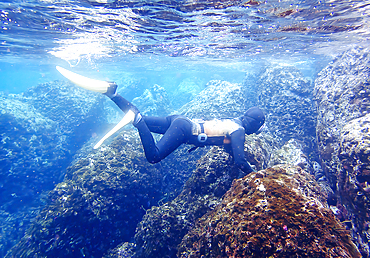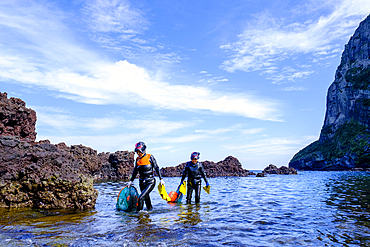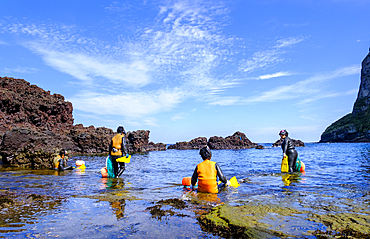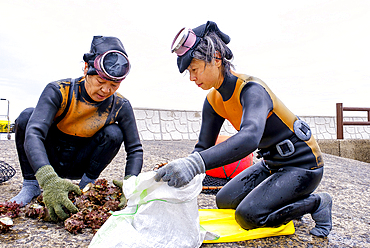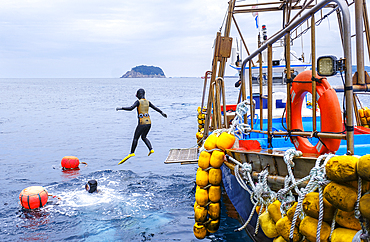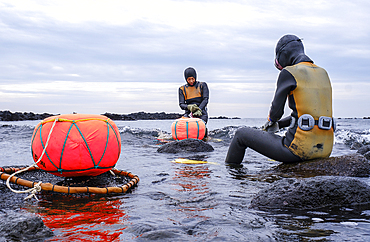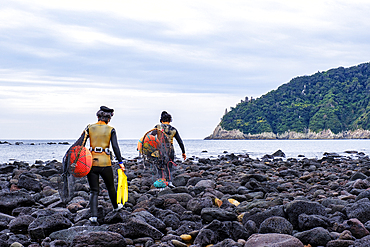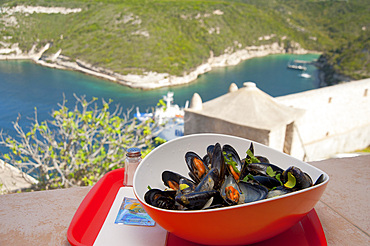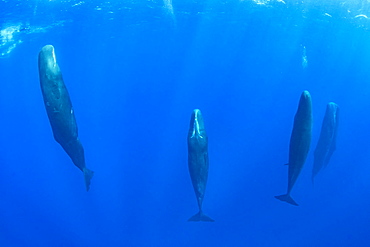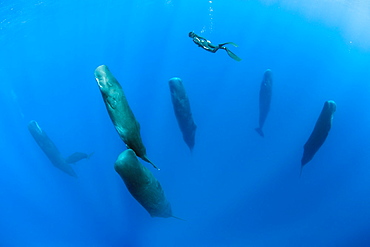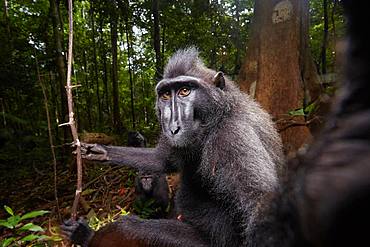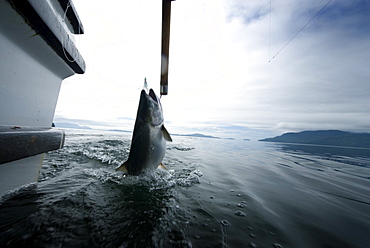Recent searches
Loading...
1243-543 - Panoramic view of vineyards and mountains near Wellington, a town in the Western Cape Winelands, a 45-minute drive from Cape Town, in South Africa with a population of approximately 62,000
1111-272 - Haenyeo women, famous for diving into their eighties and holding their breath for up to two minutes, free-diving for seafood and crustaceans, Jeju Island, South Korea, Asia
1111-271 - Haenyeo women, famous for diving into their eighties and holding their breath for up to two minutes, free-diving for seafood and crustaceans, Jeju Island, South Korea, Asia
1111-270 - Haenyeo women, famous for diving into their eighties and holding their breath for up to two minutes, free-diving for seafood and crustaceans, Jeju Island, South Korea, Asia
1111-267 - Haenyeo diving for conch, octopus, seaweed, and other seafood. Famous for diving into their eighties for being able to hold their breath for up to two minutes, the Haenyeo have harvested Jeju's oceans for hundreds of years.
1111-266 - Haenyeo diving for conch, octopus, seaweed, and other seafood. Famous for diving into their eighties for being able to hold their breath for up to two minutes, the Haenyeo have harvested Jeju's oceans for hundreds of years.
1111-265 - Haenyeo diving for conch, octopus, seaweed, and other seafood. Famous for diving into their eighties for being able to hold their breath for up to two minutes, the Haenyeo have harvested Jeju's oceans for hundreds of years.
1111-254 - Haenyeo women sort their catch. They dive for conch, octopus, seaweed, and other seafood. Famous for diving into their eighties for being able to hold their breath for up to two minutes, the Haenyeo have harvested Jeju's oceans for hundreds of years.
1111-253 - Haenyeo divers, famous for diving into their eighties and holding their breath for up to two minutes, diving for conch, octopus, seaweed, and other seafood, Jeju, South Korea, Asia
1111-252 - Haenyeo diving for conch, octopus, seaweed, and other seafood. Famous for diving into their eighties for being able to hold their breath for up to two minutes, the Haenyeo have harvested Jeju's oceans for hundreds of years.
1111-250 - Haenyeo divers, famous for diving into their eighties and holding their breath for up to two minutes, diving for conch, octopus, seaweed, and other seafood, Jeju, South Korea, Asia
1111-251 - Haenyeo diving for conch, octopus, seaweed, and other seafood. Famous for diving into their eighties for being able to hold their breath for up to two minutes, the Haenyeo have harvested Jeju's oceans for hundreds of years.
832-399690 - Turn back time - concept of turning clock backwards
746-92114 - La Minute Moule restaurant, Bonifacio, South Corse, France, Europe
1178-40228 - Garlic, miniature pumpkins and squash at market
1350-3622 - Dubrovnik Cable Car, a 4-minute ride transports visitors 778 meters to a plateau offering Old City views & a restaurant.
1178-32909 - Caucasian couple playing miniature golf
1178-33212 - Mixed race scientist dropping leaf in test tube
1178-32910 - Caucasian couple playing miniature golf
1350-91 - A telescopic closeup of Comet Lovejoy (C/2014 Q2) on January 19, 2015. I shot this from near Silver City, New Mexico, using a TMB 92mm apo refractor at f/4.4 and using a Canon 6D at ISO 1600 for a stack of 4 x 5 minute exposures. The ion tail is primarily from a single exposure to minimize blurring from the comet's motion relative to the stars. The rest of the image is from the stacked combination to minimize noise.
1350-29 - Omega Centauri globular cluster, with Canon 20Da camera with 4-inch Astro-Physics Traveler apo refractor at f/6 for 4 minutes each at ISO800. Stack of 4 exposures, averaged stacked. Plus short 2-minute exposure for core area. Taken from Queensland, Australia, July 2006.
1350-25 - The Pleiades star cluster, aka Seven Sisters, or M45, in Taurus. A deep exposure showing the reflection nebulosity which fills the area. This is a stack of 5 x 14 minute exposures with the TMB 92mm apo refractor and Borg 0.85x flattener/reducer at f/4.8 and Canon 5D MkII at ISO 800. Taken from home Oct 9/10, 2013.
1350-28 - The Carina Nebula (aka Eta Carinae) in the southern sky, shot December 11, 2012 from Timor Cottage, Coonabarabran, NSW, Australia. This is a stack of 5 x 12 minute exposures at ISO 400 with the Canon 5D MkII (filter modified) and Astro-Physics 105mm Traveler apo refractor and 6x7 field flattener.
1350-1587 - 5 minutes before `Mascleta´, in Plaza del Ayuntamiento,Fallas festival,Valencia,Spain
1350-18 - Gum Nebula area of Vela and Puppis. Taken from Atacama Lodge, Chile, March 19, 2010, with modified Canon 5D MkII and Sigma 50mm lens at f/4, for stack of 10 x 6 minute exposures (Mean combined) at ISO 800 plus 2 x 6 minutes with Kenko Softon filter. High contrast boost and Selective Colour adjustments to bring out nebulocity while retaining neutral sky.
1350-33 - Sagittarius and Scorpius in diagonal framing, with Milky Way from Ara to Serpens. Taken with 50mm Sigma lens at f/4 and Canon 5D MkII at ISO 800 for stack of just 2 frames each at 6 minutes. Cloud prevented more exposures. Taken from Atacama Lodge, San Pedro de Atacama, Chile.
1350-21 - M33, the Triangulum Spiral, a dwarf spiral in the Local Group. This is a 6-image stack of 12-minute exposures with the Canon 7D at ISO 800 on the 130mm Astro-Physics apo refractor at f/6 on AP 600E mount and SBIG SG4 autoguider. Poor seeing bloated star images somewhat.
1350-60 - A stack of 25 x 2-minute exposures with Canon 200mm f/2.8 lens at f/4 and at ISO 1600 with Canon 6D.
1350-15 - Comet Hartley 2 near the Pacman Nebula, NGC 281, in Cassiopeia. Stack of 4 x 6 minute exposures at ISO 1600 with Canon 5D MkII on A&M 105mm apo refractor at f/4.8 with Borg reducer/flattener. Bright star is Alpha Cas, Schedar. Autoguided with Celestron NexGuide autoguider. However, image of comet core is from only one exposure to minimize trailing from this fast-moving comet.
1350-67 - A demo image with the Orion 80mm CF Apo and Celestron AVX mount, with 3 x 8 minute and 3 x 6 minutes, at ISO 1600 with Canon 6D MkII plus shorter 3 x 2 minute and 3 x 1 minute exposures blended in with luminosity masks. Guided with the Orion Starshoot and Orion finderscope, using PHD2, with a lot of wild excursions in the guiding.
1350-17 - Nebulosity in the heart of Cygnus the Swan, including the North America Nebula and Pelican Nebula at left (NGC 7000 and IC 5070) and Gamma Cygni complex at right (IC 1318). The Crescent Nebula (NGC 6888) is at lower right. This is a stack of 5 x 4 minute exposures at f/2 with the 135mm lens and modified Canon 5D MkII at ISO 800, plus another three similar exposure images but taken thru the Kenko Softon filter for the star glows. Taken from home Sept 10, 2013.
1350-125 - The waning gibbous Moon approaches the star Aldebaran at an occultation on the morning of September 12, 2017. This is a multiple exposure composite of the ingress phase that occurred before sunrise, with the Moon from the final exposure and the star from exposures taken at 4-minute intervals prior to that last exposure. For the actual ingress I switched to HD movie to shoot a video of the event.
1350-23 - Orion Nebula region with NGC1973-7. Stack of two 10-minute exposures + stack of 30s and 1min exposure for retaining bright core deail. Blended with Normal @ 85% but erasing all of short exposure layer except for core.
1350-37 - Total eclipse of the Moon, December 20/21, 2010, taken from home with 130mm AP apo refractor at f/6 and Canon 7D at ISO 400. An HDR composite of 9 images from 1/125 second to 2 seconds, composited in Photoshop CS5. Vibrancy increased to show bring out the colour variations across the shadow and at the edge of the shadow. Taken at about 12:21 am MST on Dec 21, about 20 minutes before totality began, during the partial phase.
1350-123 - NGC 7000, the North America Nebula, with the Pelican Nebula, IC 5067, at right, in Cygnus, taken from home November 21, 2016 as part of testing of the Explore Scientific FCD100 102mm apo refractor. This is a stack of 5 x 6-minute exposures at f/7 with the ES field flattener, and at ISO 1600 with the filter-modified Canon 5D MkII. Star diffraction spikes added with AstronomyTools actions.
1350-20 - M31 Andromeda Galaxy, with TMB 92mm apo refractor and Borg 0.85x reducer/flattener for f/4.8 and Canon 20Da camera at ISO400 for 2 x 15 minute exposures. North is at bottom, south at top (better balance with this framing)
1350-92 - Comet Lovejoy (C/2104 Q2) on the night of Dec. 27/28, 2014, as it was approaching the globular cluster M79 at upper right, in Lepus. This is a stack of 5 x 3 minute exposures at ISO 2500 with the Canon 5D MkII and TMB 92mm refractor at f/4.4. Taken from near Silver City, New Mexico.
1348-3 - Pediatric nurse is examining a newborn baby a few minutes after the birth.
1348-4 - Pediatric nurse is examining a newborn baby a few minutes after the birth.
1116-49651 - A Whip coral goby (Bryaninops amplus) on whip coral (Junceella fragilis), Philippines
832-386561 - Bronze statue man with rifle, memorial for the minute Man John Parker, Lexington Battle Green, Lexington, Massachussets, USA, North America
746-88985 - La Minute Moule restaurant, Bonifacio, South Corse, France, Europe
860-287910 - Pod of Sleeping sperm whale (Physeter macrocephalus) Researchers first saw this unusual sleep behavior in sperm whales in 2008. The scientists in that study found that sperm whales dozed in this upright drifting posture for about 10 to 15 minutes at a time, Vulnerable (IUCN). The sperm whale is the largest of the toothed whales. Sperm whales are known to dive as deep as 1,000 meters in search of squid to eat. Dominica, Caribbean Sea, Atlantic Ocean. Photo taken under permit n°RP 16-02/32 FIS-5.
860-287909 - Pod of sperm whale relaxing after a short sleep (Physeter macrocephalus) Researchers first saw this unusual sleep behavior in sperm whales in 2008. The scientists in that study found that sperm whales dozed in this upright drifting posture for about 10 to 15 minutes at a time, Vulnerable (IUCN). The sperm whale is the largest of the toothed whales. Sperm whales are known to dive as deep as 1,000 meters in search of squid to eat. Dominica, Caribbean Sea, Atlantic Ocean. Photo taken under permit n°RP 16-02/32 FIS-5.
860-287914 - Free diver is swimming over a pod of Sleeping sperm whale (Physeter macrocephalus) Researchers first saw this unusual sleep behavior in sperm whales in 2008. The scientists in that study found that sperm whales dozed in this upright drifting posture for about 10 to 15 minutes at a time, Vulnerable (IUCN). The sperm whale is the largest of the toothed whales. Sperm whales are known to dive as deep as 1,000 meters in search of squid to eat. Dominica, Caribbean Sea, Atlantic Ocean. Photo taken under permit n°RP 16-02/32 FIS-5.
860-287906 - Pod of Sleeping sperm whale (Physeter macrocephalus) Researchers first saw this unusual sleep behavior in sperm whales in 2008. The scientists in that study found that sperm whales dozed in this upright drifting posture for about 10 to 15 minutes at a time, Vulnerable (IUCN). The sperm whale is the largest of the toothed whales. Sperm whales are known to dive as deep as 1,000 meters in search of squid to eat. Dominica, Caribbean Sea, Atlantic Ocean. Photo taken under permit n°RP 16-02/32 FIS-5.
860-287912 - Snorkeler photographing a pod of Sleeping sperm whale (Physeter macrocephalus) Researchers first saw this unusual sleep behavior in sperm whales in 2008. The scientists in that study found that sperm whales dozed in this upright drifting posture for about 10 to 15 minutes at a time, Vulnerable (IUCN). The sperm whale is the largest of the toothed whales. Sperm whales are known to dive as deep as 1,000 meters in search of squid to eat. Dominica, Caribbean Sea, Atlantic Ocean. Photo taken under permit n°RP 16-02/32 FIS-5.
860-287266 - This big male of the critically-endangered celebes crested macaque (Macaca nigra) was photographed in the national park of tangkoko (Sulawesi - Indonesia) then we followed this macaca group from few days with a scientist and a local guide for a monitoring. This male was moving with the group an take a few minutes break by sitting just a few meters from me. I take two pictures then I leaved to follow the scientist. finaliste à Namur
846-2973 - Boats on the Nam Ou River about 20 minutes north of Nong Khiaw, Luang Prabang Province, Northern Laos, Laos, Indochina, Southeast Asia, Asia
1116-42585 - 6 Minute Exposure Of An Old Dock, Queen Elizabeth Provincial Park, Alberta, Canada
1174-5535 - Old Clock in Front of Flag, New York, New York, United States of America
1283-23 - Elevated view over the old town of Dubrovnik at dusk, minutes before the rainfall, UNESCO World Heritage Site, Dubrovnik, Croatia, Europe
764-5912 - Impala (Aepyceros melampus) doe and minutes-old calf, Ngorongoro Conservation Area, Tanzania, East Africa, Africa
857-94287 - Thomas Coville and the Ultime Class 100' VPLP designed trimaran Sodebo in Rio de Janeiro, Brazil. Thomas Coville (FRA) and his 31m maxi trimaran Sodebo Ultim? has successfully broken the solo round the world record, completing the 28400 nm route in 49 days 3 hours 7 minutes and 38 seconds.
857-94289 - Thomas Coville and the Ultime Class 100' VPLP designed trimaran Sodebo in Rio de Janeiro, Brazil. Thomas Coville (FRA) and his 31m maxi trimaran Sodebo Ultim? has successfully broken the solo round the world record, completing the 28400 nm route in 49 days 3 hours 7 minutes and 38 seconds.
857-94288 - Thomas Coville and the Ultime Class 100' VPLP designed trimaran Sodebo in Rio de Janeiro, Brazil. Thomas Coville (FRA) and his 31m maxi trimaran Sodebo Ultim? has successfully broken the solo round the world record, completing the 28400 nm route in 49 days 3 hours 7 minutes and 38 seconds.
764-5804 - Impala (Aepyceros melampus) doe and minutes-old calf, Ngorongoro Conservation Area, Tanzania, East Africa, Africa
857-92081 - Camels drink at a water trough at Abu Gadam in the Saharan Desert, Sudan. Think 25 gallons of water in 10 minutes.
857-91048 - August 18, 08 A Coho salmon is caught off the coast of Prince of Whales Island Alaska. Trolling for salmon is considered the "high-end" fishery because the way they catch is not harmful to the fish, in fact any by-catch or non-keeper salmon can be tossed back with little damage to the fish. So since the fish are in such good shape when caught, on individual hooks on long lines, they can be brought in and prepared or dressed (gutted and bled) and then iced within minutes and then within hours are on the troll tender that fillets and vacume pacs and then flash freezes them, so that most of the fresh caught fish for pricier consumption is troller caught, United States of America
1178-11147 - Minute House (childhood home of Franz Kafka) in Prague
712-2639 - Balezino, 23 minutes stop at the railway station on the Trans-Siberian line, Udmurtia, Russia, Europe
712-2638 - Fish seller at Balezino, 23 minutes stop at the railway station on the Trans-Siberian line, Udmurtia, Russia, Europe
803-98 - Old North Bridge, Minute Man National Historic Park, Concord, Massachusetts, United States of America, North America
817-428971 - sundial at Meissen guildhall, Meissen, Saxony, Germany, Europe
829-1657 - House at the Minute, a renaissance building featuring architectural sgraffito on the Old Town Square, Prague, Czech Republic, Europe
857-63358 - Young boy with a dead frog he found. Gbolokai is a small town of a few hundred people 20 minutes off the main road near Totota, all of its inhabitants fled during the long brutal civil war and have slowly returned after 2005 to try and rebuild their lives.
857-69068 - Chinese mourners shout nationalist slogans after a three minute silence to grieve Sichuan's earthquake victims in Chengdu's central square.
857-71071 - A display of clocks and watches for sale in a market in Xining in China's western Qinghai province.
857-63356 - Young mother working outside her home with her young son in the background playing with an old bike rim. Gbolokai is a small town of a few hundred people 20 minutes off the main road near Totota, all of its inhabitants fled during the long brutal civil war and have slowly returned after 2005 to try and rebuild their lives.
857-69063 - Chinese mourners hold hands in the central square of Chengdu as they observe three minutes of silence to grieve Sichuan's earthquake victims.
857-69066 - Chinese mourners hold hands in the central square of Chengdu as they observe three minutes of silence to grieve Sichuan's earthquake victims.
857-69071 - Chinese mourners shout nationalist slogans after a three minute silence to grieve Sichuan's earthquake victims in Chengdu's central square.
857-63357 - Young girl smiling. Gbolokai is a small town of a few hundred people 20 minutes off the main road near Totota, all of its inhabitants fled during the long brutal civil war and have slowly returned after 2005 to try and rebuild their lives.
857-63360 - Portrait of a young boy wearing bright orange glasses and a sling shot around his neck. Gbolokai is a small town of a few hundred people 20 minutes off the main road near Totota, all of its inhabitants fled during the long brutal civil war and have slowly returned after 2005 to try and rebuild their lives.
857-66658 - Seven workers are disassembling computers at TES-AMM Shanghai, which was founded on September 21, 2005, currently has 67 employees of which 26 are workers. With an annual production capacity of 10,000 tons, it has only treated 2,000 tons of e-waste from its founding more than a year ago. 'The biggest problem is that there isn't an e-waste recycling channel in China. The biggest chunks of raw materials we get are from government bodies, which are upgrading their equipments, and electronic appliances franchises that are washing out their outdated inventories. We don't have any imported e-waste because that's banned by the government. It takes a worker no more than ten minutes to disassemble a computer, and each worker can deal with between 60 to 70 computers a day,' says Janice Wu, who's the Environment & Quality Management Dept. Manager and Plant Manager Assistant.
817-401815 - Tourist waiting for Strokkur geyser to erupt, Iceland Strokkur is a fountain geyser in the geothermal area beside the Hvita River It is one of Iceland´s most famous geysers, erupting about every 4-8 minutes and 15 - 20 m high, sometimes up to 40 m high
817-401816 - Tourist waiting for Strokkur geyser to erupt, Iceland Strokkur is a fountain geyser in the geothermal area beside the Hvita River It is one of Iceland´s most famous geysers, erupting about every 4-8 minutes and 15 - 20 m high, sometimes up to 40 m high
857-51938 - An immigration activist stands surrounded by waving American flags at a Minute Men ralley in San Diego, California.
857-47481 - Hispanic workers at Catalina Offshore Products in San Diego, Ca. inspect, prepare and clean sea urchin. Urchin meat has a tiny shelf life, meaning, the fresh meter starts ticking the minute a diver breaks the surface with a full catch bag. After proce
857-47479 - Sea urchin lies in a tray prior to packaging at Catalina Offshore Products in San Diego, Ca. Urchin meat has a tiny shelf life, meaning, the fresh meter starts ticking the minute a diver breaks the surface with a full catch bag. After processing, jetl
857-47486 - Hispanic workers at Catalina Offshore Products in San Diego, Ca. inspect, prepare and clean sea urchin. Urchin meat has a tiny shelf life, meaning, the fresh meter starts ticking the minute a diver breaks the surface with a full catch bag. After proce
857-47494 - A Hispanic worker at Catalina Offshore Products in San Diego, Ca. inspects and prepares sea urchin. Urchin meat has a tiny shelf life, meaning, the fresh meter starts ticking the minute a diver breaks the surface with a full catch bag. After processing
857-7111 - The Fountains of Bellagio peform in front of the Bellagio Hotel in Las Vegas, NV. Playing as often as every 15 minutes, the fountains are a popular destination for tourists. The Bellagio, one of Las Vegas' most expensive and newest hotels, opened for business in October 1999.
908-172 - Cuttlefish (Sepia officinalis) Two mating head to head within minutes of first encounter. Babbacombe, Torquay, South Devon, UK
(RR)
995-94 - Eider duck (Somateria mollissima), male in flight. The first few males arriving to a location which in minutes will become an Eider winter raft.
979-9321 - Adult gentoo penguin (Pygoscelis papua) feeding minutes-old newly hatched chick at Gold Harbor on South Georgia, Southern Ocean
29-5109 - Strokkur at full height, the powerful geyser that erupts every 10 minutes, beside the now-inactive Geysir, southeast Iceland, Iceland, Polar Regions
829-977 - Dwarf or Minute Leaf chameleon (Brookesia minima) on a man's finger Montagne D'Ambre National Park in northern Madagascar, Madagascar, Africa
829-976 - Dwarf or Minute Leaf chameleon (Brookesia minima) photographed in the palm of a man's hand in Montagne D'Ambre National Park in northern Madagascar, Madagascar, Africa
817-126321 - Grand Prismatic Spring Midway Geyser Basin Yellowstone National Park Wyoming USA Considered to be the largest hot spring in Yellowstone Discharges about 550 gallons of water poer minute
770-1180 - Tourists watching geyser erupting, Strokkur (the Churn) erupts every 5-10 minutes to heights of up to 20 meters (70ft), Geysir, Golden Circle, Iceland, Polar Regions
770-1171 - Strokkur (the Churn) erupts every 5-10 minutes to heights of up to 20 meters (70ft), Geysir, Golden Circle, Iceland, Polar Regions



